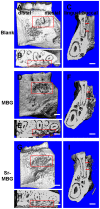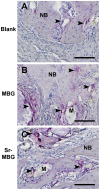Periodontal regeneration using strontium-loaded mesoporous bioactive glass scaffolds in osteoporotic rats
- PMID: 25116811
- PMCID: PMC4130544
- DOI: 10.1371/journal.pone.0104527
Periodontal regeneration using strontium-loaded mesoporous bioactive glass scaffolds in osteoporotic rats
Abstract
Recent studies demonstrate that the rate of periodontal breakdown significantly increased in patients compromised from both periodontal disease and osteoporosis. One pharmacological agent used for their treatment is strontium renalate due to its simultaneous ability to increase bone formation and halt bone resorption. The aim of the present study was to achieve periodontal regeneration of strontium-incorporated mesoporous bioactive glass (Sr-MBG) scaffolds in an osteoporotic animal model carried out by bilateral ovariectomy (OVX). 15 female Wistar rats were randomly assigned to three groups: control unfilled periodontal defects, 2) MBG alone and 3) Sr-MBG scaffolds. 10 weeks after OVX, bilateral fenestration defects were created at the buccal aspect of the first mandibular molar and assessed by micro-CT and histomorphometric analysis after 28 days. Periodontal fenestration defects treated with Sr-MBG scaffolds showed greater new bone formation (46.67%) when compared to MBG scaffolds (39.33%) and control unfilled samples (17.50%). The number of TRAP-positive osteoclasts was also significantly reduced in defects receiving Sr-MBG scaffolds. The results from the present study suggest that Sr-MBG scaffolds may provide greater periondontal regeneration. Clinical studies are required to fully characterize the possible beneficial effect of Sr-releasing scaffolds for patients suffering from a combination of both periodontal disease and osteoporosis.
Conflict of interest statement
Figures





Similar articles
-
A comparative study of Sr-incorporated mesoporous bioactive glass scaffolds for regeneration of osteopenic bone defects.Osteoporos Int. 2014 Aug;25(8):2089-96. doi: 10.1007/s00198-014-2735-0. Epub 2014 May 8. Osteoporos Int. 2014. PMID: 24807629
-
Effect of enamel matrix derivative on periodontal wound healing and regeneration in an osteoporotic model.J Periodontol. 2014 Nov;85(11):1603-11. doi: 10.1902/jop.2014.130745. Epub 2014 May 26. J Periodontol. 2014. PMID: 24857323
-
Strontium-containing mesoporous bioactive glass scaffolds with improved osteogenic/cementogenic differentiation of periodontal ligament cells for periodontal tissue engineering.Acta Biomater. 2012 Oct;8(10):3805-15. doi: 10.1016/j.actbio.2012.06.023. Epub 2012 Jun 28. Acta Biomater. 2012. PMID: 22750735
-
Evaluating the Effect of Non-cellular Bioactive Glass-Containing Scaffolds on Osteogenesis and Angiogenesis in in vivo Animal Bone Defect Models.Front Bioeng Biotechnol. 2020 May 14;8:430. doi: 10.3389/fbioe.2020.00430. eCollection 2020. Front Bioeng Biotechnol. 2020. PMID: 32478053 Free PMC article.
-
Advanced applications of strontium-containing biomaterials in bone tissue engineering.Mater Today Bio. 2023 Apr 15;20:100636. doi: 10.1016/j.mtbio.2023.100636. eCollection 2023 Jun. Mater Today Bio. 2023. PMID: 37441138 Free PMC article. Review.
Cited by
-
Applications of Bioactive Strontium Compounds in Dentistry.J Funct Biomater. 2024 Jul 31;15(8):216. doi: 10.3390/jfb15080216. J Funct Biomater. 2024. PMID: 39194654 Free PMC article. Review.
-
Bioactive Glasses in Periodontal Regeneration: Existing Strategies and Future Prospects-A Literature Review.Materials (Basel). 2022 Mar 16;15(6):2194. doi: 10.3390/ma15062194. Materials (Basel). 2022. PMID: 35329645 Free PMC article. Review.
-
Application of a direct pulp capping cement containing S-PRG filler.Clin Oral Investig. 2019 Apr;23(4):1723-1731. doi: 10.1007/s00784-018-2596-6. Epub 2018 Aug 29. Clin Oral Investig. 2019. PMID: 30159805
-
The Effect of Strontium Ranelate Gel on Bone Formation in Calvarial Critical Size Defects.Open Access Maced J Med Sci. 2017 Dec 12;5(7):994-999. doi: 10.3889/oamjms.2017.164. eCollection 2017 Dec 15. Open Access Maced J Med Sci. 2017. PMID: 29362634 Free PMC article.
-
Influence of Strontium on the Biological Behavior of Bioactive Glasses for Bone Regeneration.Materials (Basel). 2023 Dec 15;16(24):7654. doi: 10.3390/ma16247654. Materials (Basel). 2023. PMID: 38138796 Free PMC article. Review.
References
-
- Genant HK, Cooper C, Poor G, Reid I, Ehrlich G, et al. (1999) Interim report and recommendations of the World Health Organization Task-Force for Osteoporosis. Osteoporos Int 10: 259–264. - PubMed
-
- Rodan GA, Martin TJ (2000) Therapeutic approaches to bone diseases. Science 289: 1508–1514. - PubMed
-
- Silva BC, Bilezikian JP (2011) New approaches to the treatment of osteoporosis. Annu Rev Med 62: 307–322. - PubMed
-
- Boonen S, Ferrari S, Miller PD, Eriksen EF, Sambrook PN, et al. (2012) Postmenopausal osteoporosis treatment with antiresorptives: effects of discontinuation or long-term continuation on bone turnover and fracture risk–a perspective. J Bone Miner Res 27: 963–974. - PubMed
Publication types
MeSH terms
Substances
LinkOut - more resources
Full Text Sources
Other Literature Sources
Medical
Research Materials

